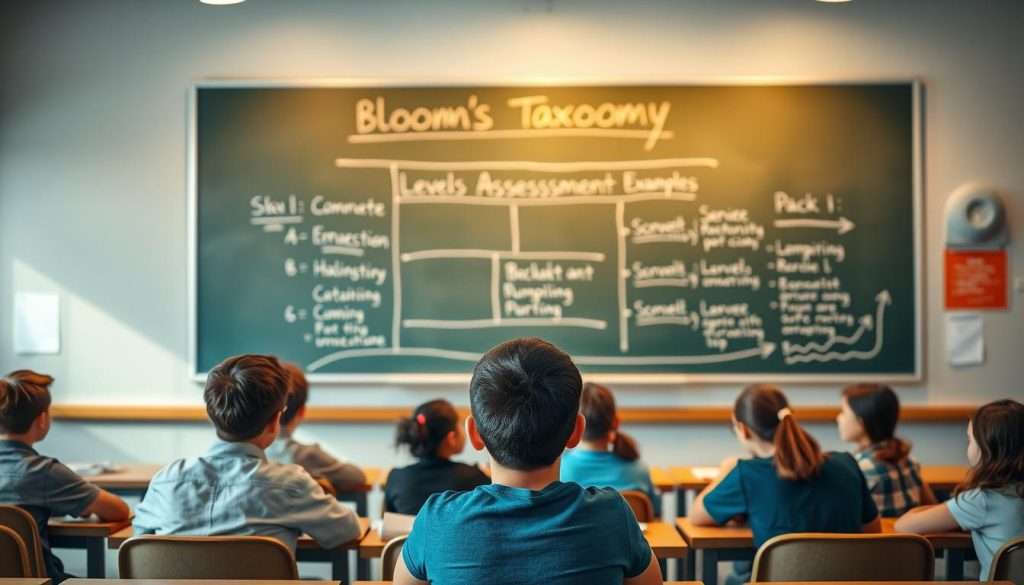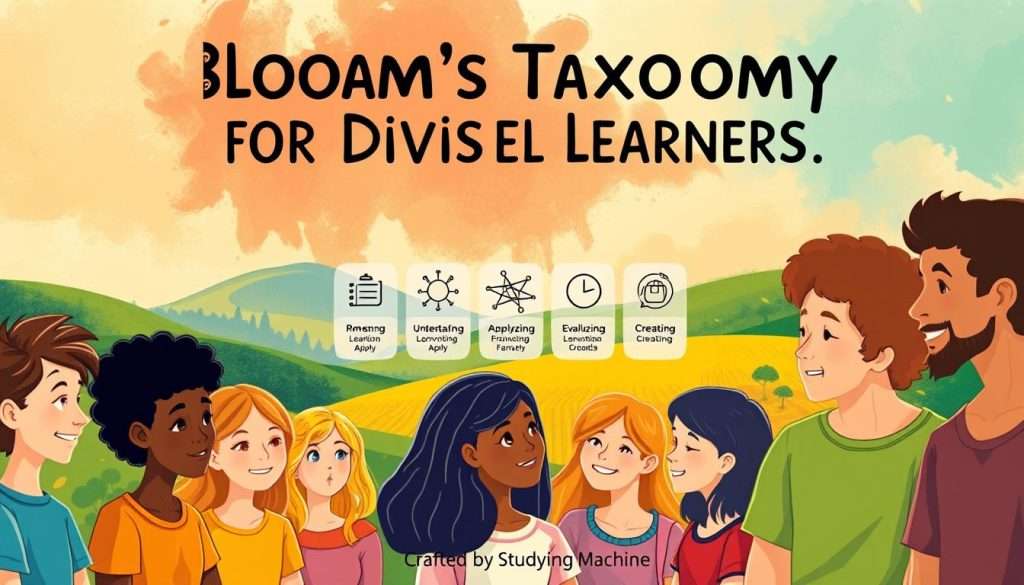Welcome to our guide on Bloom’s Taxonomy, a key educational framework for better teaching and learning!
Benjamin Bloom and his team introduced it in 1956. It organizes learning objectives to make studying more effective and fun.
By using Bloom’s Taxonomy, you can make learning more engaging and rewarding. Our guide is for students and lifelong learners alike. It covers everything you need to know about this framework.
Key Takeaways
- Understand the origins and purpose of Bloom’s Taxonomy
- Learn how to apply this educational framework to your learning objectives
- Discover how to make studying a more enjoyable experience
- Explore practical applications of Bloom’s Taxonomy in teaching and learning
- Create a more engaging and effective learning environment
What is Bloom’s Taxonomy and Why It Matters
Knowing Bloom’s Taxonomy is key for good teaching and learning. It’s a big part of educational psychology. It helps teachers set up learning goals and tests.
The Origins and Evolution of the Taxonomy
Bloom’s Taxonomy started in 1956 by Benjamin Bloom and his team. It sorts learning goals into different levels.
Benjamin Bloom’s Original Framework (1956)
The first version had six main categories: Knowledge, Comprehension, Application, Analysis, Synthesis, and Evaluation. These levels were arranged in a hierarchy, with each one building on the last.
The Revised Taxonomy (2001)
In 2001, a new version of Bloom’s Taxonomy came out. It has levels like Remember, Understand, Apply, Analyze, Evaluate, and Create. This update made the taxonomy more flexible and suited for today’s education.
Here’s a comparison of the old and new taxonomies:
| Original Taxonomy (1956) | Revised Taxonomy (2001) |
|---|---|
| Knowledge | Remember |
| Comprehension | Understand |
| Application | Apply |
| Analysis | Analyze |
| Synthesis | Create |
| Evaluation | Evaluate |
Understanding these levels helps teachers design better learning experiences. Bloom’s Taxonomy is still a crucial part of educational psychology. It improves teaching methods and student results.
The Six Levels of Bloom’s Taxonomy Explained
Let’s explore the six levels of Bloom’s Taxonomy and how they boost cognitive skills. Bloom’s Taxonomy sorts learning goals into six levels. Each level shows a more complex thinking process.
Remembering: Building the Knowledge Foundation
The first level, “Remembering,” is about recalling important information. It’s key for building a solid knowledge base.
Key Action Verbs and Activities
- List, define, and describe key terms.
- Try out flashcard exercises and quizzes.
Understanding: Demonstrating Comprehension
“Understanding” means learners show they get it by interpreting and summarizing info.
Key Action Verbs and Activities
- Summarize, paraphrase, and explain concepts.
- Join group discussions and make concept maps.
Applying: Putting Knowledge to Use
“Applying” means using what you’ve learned to solve problems or finish tasks.
Key Action Verbs and Activities
- Use, apply, and demonstrate knowledge in real-life scenarios.
- Get involved in project-based learning and case studies.
Analyzing: Breaking Down Information
At the “Analyzing” level, learners break down info into parts to grasp its structure.
Key Action Verbs and Activities
- Compare, contrast, and analyze data.
- Do data analysis and make comparative charts.
| Taxonomy Level | Key Action Verbs | Example Activities |
|---|---|---|
| Remembering | List, Define, Describe | Flashcards, Quizzes |
| Understanding | Summarize, Paraphrase, Explain | Group Discussions, Concept Maps |
| Applying | Use, Apply, Demonstrate | Project-Based Learning, Case Studies |
Evaluating: Making Informed Judgments
“Evaluating” is about making smart choices based on criteria and standards.
Key Action Verbs and Activities
- Assess, evaluate, and justify decisions.
- Take part in peer review and debates.
Creating: Generating Original Work
The top level, “Creating,” asks learners to make something new by mixing elements in fresh ways.
Key Action Verbs and Activities
- Design, create, and construct new products or ideas.
- Join brainstorming sessions and work on innovative projects.
By knowing and using these six levels, teachers can set learning objectives that encourage higher order thinking and improve cognitive skills.
How to Create Effective Learning Objectives Using Bloom’s Taxonomy
Learning objectives are like a map for your education. Bloom’s Taxonomy helps you make them clear and effective. By using Bloom’s Taxonomy, you can make sure your teaching is focused and helps students learn well.
Step-by-Step Guide to Writing Objectives
To write good learning objectives, first pick the cognitive level you aim for. Do you want students to just know something, or to use what they’ve learned? Choose verbs from Bloom’s Taxonomy to write your objectives. For example, for “Understanding,” use verbs like “describe,” “explain,” or “summarize.”
Here’s a simple guide:
- Identify the cognitive level.
- Choose a verb from Bloom’s Taxonomy that matches this level.
- Write your objective, making sure it’s clear and measurable.
Matching Objectives to Cognitive Levels
Each cognitive level needs its own type of objective. “Remembering” is about recalling facts, while “Creating” is about making new ideas or products. By matching your objectives to the right cognitive level, you challenge your learners in the right way.
As Benjamin Bloom said, “The ultimate goal of education is to focus on learning, not teaching.”
“The ultimate goal of education is to focus on learning, not teaching.”
Examples of Well-Crafted Objectives
Here are some examples:
- For “Remembering”: “List the main causes of the American Revolution.”
- For “Analyzing”: “Compare and contrast the economic systems of capitalism and socialism.”
- For “Creating”: “Design a sustainable community, taking into account environmental, social, and economic factors.”
By using Bloom’s Taxonomy for your learning objectives, you create a framework that supports all kinds of learners. This helps students understand things more deeply.
Designing Lessons That Progress Through Taxonomy Levels
Creating lessons that move through Bloom’s Taxonomy levels is key for deep learning in students. It helps teachers make lessons more engaging and challenging.
Planning Sequential Learning Activities
To plan lessons, we start with basic knowledge and then add more complex tasks. This helps students grow in their thinking abilities.
Lower-Order to Higher-Order Thinking
Lessons should start with simple tasks and move to more complex ones. We start with remembering and understanding. Then, we move to applying, analyzing, evaluating, and creating.
- Begin with simple recall questions to lay the groundwork.
- Then, introduce tasks that need more thought and application.
- Finally, ask students to evaluate and create new ideas.
Sample Lesson Plans for Different Subjects
Let’s see how this works in different subjects. For example, in science, we might start with the water cycle. We begin with simple recall and move to more complex analysis and application.
| Taxonomy Level | Science Lesson Activity | Math Lesson Activity |
|---|---|---|
| Remembering | Recall the stages of the water cycle. | Recall basic addition facts. |
| Understanding | Explain the process of evaporation. | Understand the concept of place value. |
| Applying | Model the water cycle using a diagram. | Apply addition to solve real-world problems. |
Scaffolding Techniques for Cognitive Development
Scaffolding is key for helping students grow through the taxonomy levels. It gives them support and confidence as they learn.
Scaffolding includes breaking down tasks, giving feedback, and encouraging teamwork.
By using these strategies, we can make lessons more cohesive and challenging. This promotes higher-order thinking and cognitive growth.
Classroom Questioning Techniques Based on Cognitive Levels
Using questions in class can really boost learning by making students think harder. By asking questions at different levels of Bloom’s Taxonomy, teachers help students think more deeply and critically.
Formulating Questions for Each Taxonomy Level
To use questions well, teachers need to know how to ask at each Bloom’s Taxonomy level. For example, questions that ask students to remember might be “What is the capital of France?” or “Who wrote ‘To Kill a Mockingbird’?”
Questions that ask students to analyze and evaluate are more complex. They might be “How does the theme of ‘To Kill a Mockingbird’ relate to today’s social issues?” or “What are the good and bad points of the argument in the essay?”
Wait Time and Response Strategies
It’s important to give students time to think before answering. Studies show that waiting 3-5 seconds can make their answers better. Teachers can also use strategies like cold calling or think-pair-share to make sure everyone participates and thinks deeply.
“The key to successful questioning is not just in the questions themselves, but in how you facilitate the discussion that follows.”
Facilitating Discussions That Deepen Thinking
Good class discussions make students build on each other’s ideas and question things. Teachers can use methods like Socratic seminars or jigsaw discussions to help students understand more deeply.
By using these questioning methods, teachers can make a classroom where students think critically and engage deeply with what they’re learning.
How to Assess Student Learning Using Bloom’s Taxonomy
Assessing student learning helps you improve your teaching. Bloom’s Taxonomy is a strong educational framework. It shows the cognitive levels students are at.
Creating Level-Appropriate Assessments
Creating effective assessments is key. You need to match them with the cognitive skills you want to check. This means making questions and tasks that fit each level of Bloom’s Taxonomy.
Test Question Examples for Each Level
Here are some test question examples for each level of Bloom’s Taxonomy:
| Cognitive Level | Example Question |
|---|---|
| Remembering | What is the capital of France? |
| Understanding | Explain the concept of photosynthesis. |
| Applying | Use the formula for calculating the area of a circle to solve a real-world problem. |
| Analyzing | Compare and contrast the themes of two different novels. |
| Evaluating | Assess the effectiveness of a particular policy based on given criteria. |
| Creating | Design a new product that solves a common problem. |
Designing Performance Tasks and Projects
Performance tasks and projects are great for assessing student learning. They ask students to use their knowledge and skills in complex ways.
For example, you might ask students to make a multimedia presentation about a historical event. Or to design and conduct an experiment to test a scientific hypothesis.

Developing Rubrics Based on Taxonomy Levels
To assess student work well, you need clear and concise rubrics. These should match the learning objectives and cognitive levels you’re focusing on.
Using Bloom’s Taxonomy in your assessments helps you understand student learning better. This way, you can adjust your teaching to meet your students’ needs.
Digital Tools That Support Different Cognitive Levels
In today’s digital world, teachers have many tools to help students at different levels. These tools make learning better by focusing on various parts of education.
Apps and Websites for Knowledge Acquisition
For basic learning, many apps and websites are great. Khan Academy and Coursera let students learn at their own speed. They offer lots of courses and materials that fit each student’s needs.
Tools for Analysis and Evaluation
For critical thinking, tools that help with analysis and evaluation are key. The Graphing Calculator is good for math and science. Padlet is great for group brainstorming. These tools help students think deeply and share their ideas in new ways.
Platforms That Foster Creation and Innovation
For advanced skills like creating and innovating, tools like Tinkercad and Scratch are perfect. They let students make their ideas real, boosting creativity and innovation. Students can work on complex projects that show they understand and can apply what they’ve learned.
Implementation Strategies for the Digital Classroom
To use these digital tools well, teachers need a few strategies. First, pick tools that match your learning goals. Second, make sure everyone knows how to use them. Finally, keep checking how well they work and give feedback to improve.
Adapting Bloom’s Taxonomy for Diverse Learners
It’s important to adapt Bloom’s Taxonomy for all learners. Each student is different, with their own abilities and backgrounds. By tailoring lessons, teachers can make sure everyone is challenged and interested.
Modifications for Different Learning Abilities
Teachers can adjust lessons for various learning styles. For example, they can use pictures for visual learners or offer extra help for those with disabilities. Differentiated instruction helps all students reach their goals.
Cultural Considerations in Cognitive Development
Culture affects how students learn and interact with school. Teachers should know these differences and include diverse views in their teaching. This makes learning richer and more meaningful for students from different backgrounds.
Supporting English Language Learners
English language learners need special help. Teachers can use simpler language and provide bilingual materials. This supports their language skills and learning.
Differentiation Strategies for Mixed-Ability Classrooms
In mixed-ability classrooms, using different strategies is key. Teachers can offer tiered assignments and let students work at their own speed. Technology can also help make learning more personal. This way, all students can meet their learning objectives with support.

By making Bloom’s Taxonomy fit the needs of diverse learners, teachers can spark a lifelong love of learning.
Using Bloom’s Taxonomy for Self-Directed Learning and Study
Bloom’s Taxonomy is not just for teachers. It’s a powerful tool for learners to take charge of their education. By applying its principles, you can create a personalized learning plan. This plan will enhance your cognitive skills and foster critical thinking skills.
Creating Personal Study Plans
To start, identify your learning objectives. What do you want to achieve? Break down larger goals into smaller, manageable chunks. Align them with the appropriate taxonomy level. For instance, if you’re learning a new language, your initial objective might be to remember basic vocabulary.
Self-Assessment Techniques
Regular self-assessment is crucial. Use quizzes, flashcards, or reflective journals to evaluate your understanding. Adjust your study plan accordingly. As you progress, you’ll develop critical thinking skills by analyzing your own learning process.
Metacognitive Strategies for Deeper Learning
Metacognition involves thinking about your own thinking. Employ strategies like summarizing information in your own words or teaching someone else what you’ve learned. These techniques help solidify your understanding and promote deeper learning.
Study Methods for Different Taxonomy Levels
Different levels of Bloom’s Taxonomy require tailored study methods. For example, to achieve the “analyzing” level, you might compare and contrast different concepts or identify patterns. For “creating,” try generating new ideas or products based on what you’ve learned.
By incorporating these strategies into your self-directed learning, you’ll not only achieve your learning objectives. You’ll also develop a robust set of cognitive skills. These skills will serve you well in all areas of life.
“The beautiful thing about learning is that no one can take it away from you.” – B.B. King
Conclusion: Transforming Education Through Bloom’s Taxonomy
We’ve seen how Bloom’s Taxonomy can change teaching and learning. It offers a strong framework that boosts cognitive skills. This makes learning more effective and fun.
By using Bloom’s Taxonomy, you can improve your teaching and learning. Start by setting clear learning goals. Then, design lessons that move through the taxonomy levels. Use questions in class to encourage deep thinking.
Bloom’s Taxonomy is flexible and works for all kinds of learners. Use digital tools and check student learning with taxonomy-based methods. This makes learning more inclusive and effective.
Now, it’s your turn to change your learning experience. By using Bloom’s Taxonomy, you can reach your full potential. Studying will become more enjoyable and rewarding.

